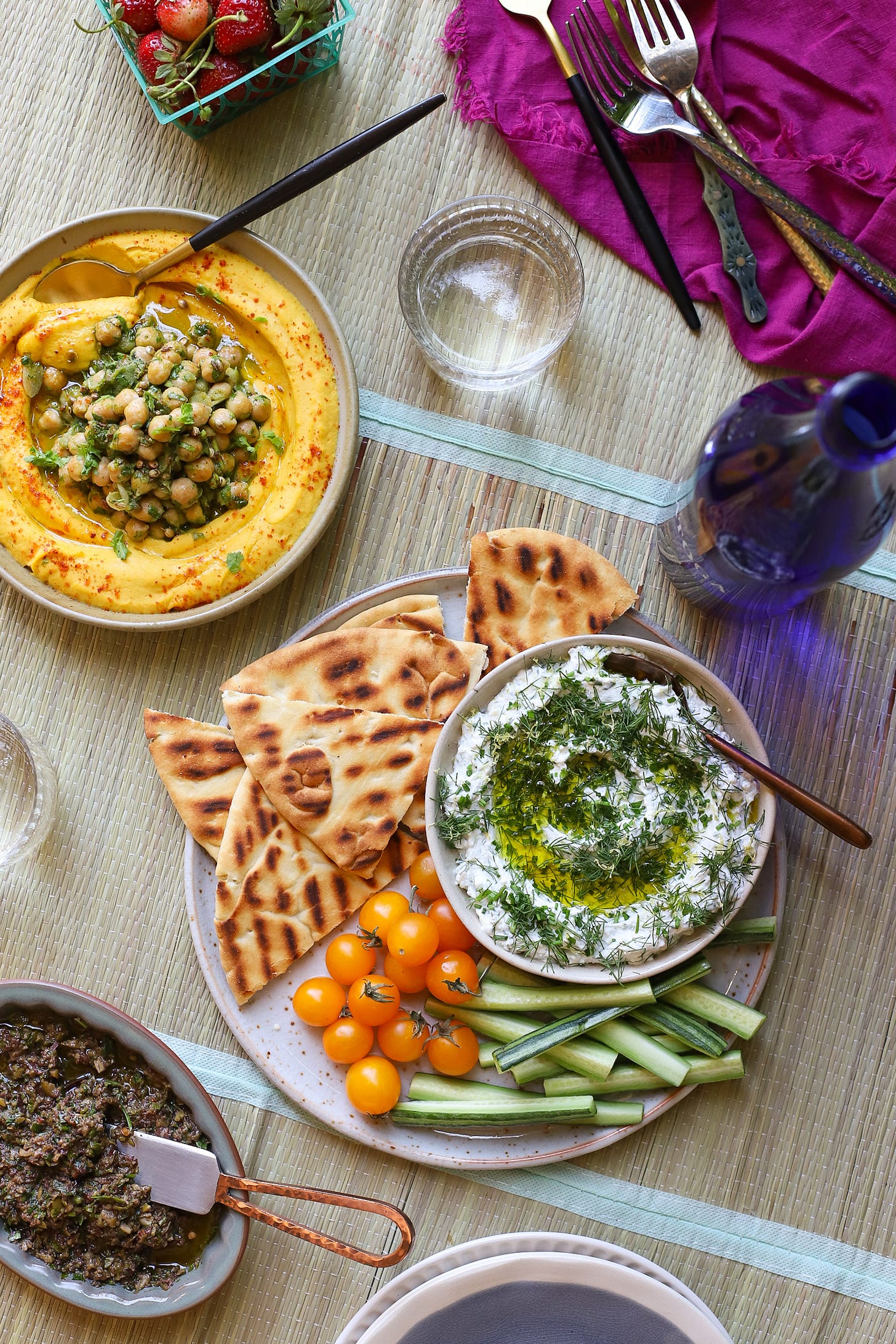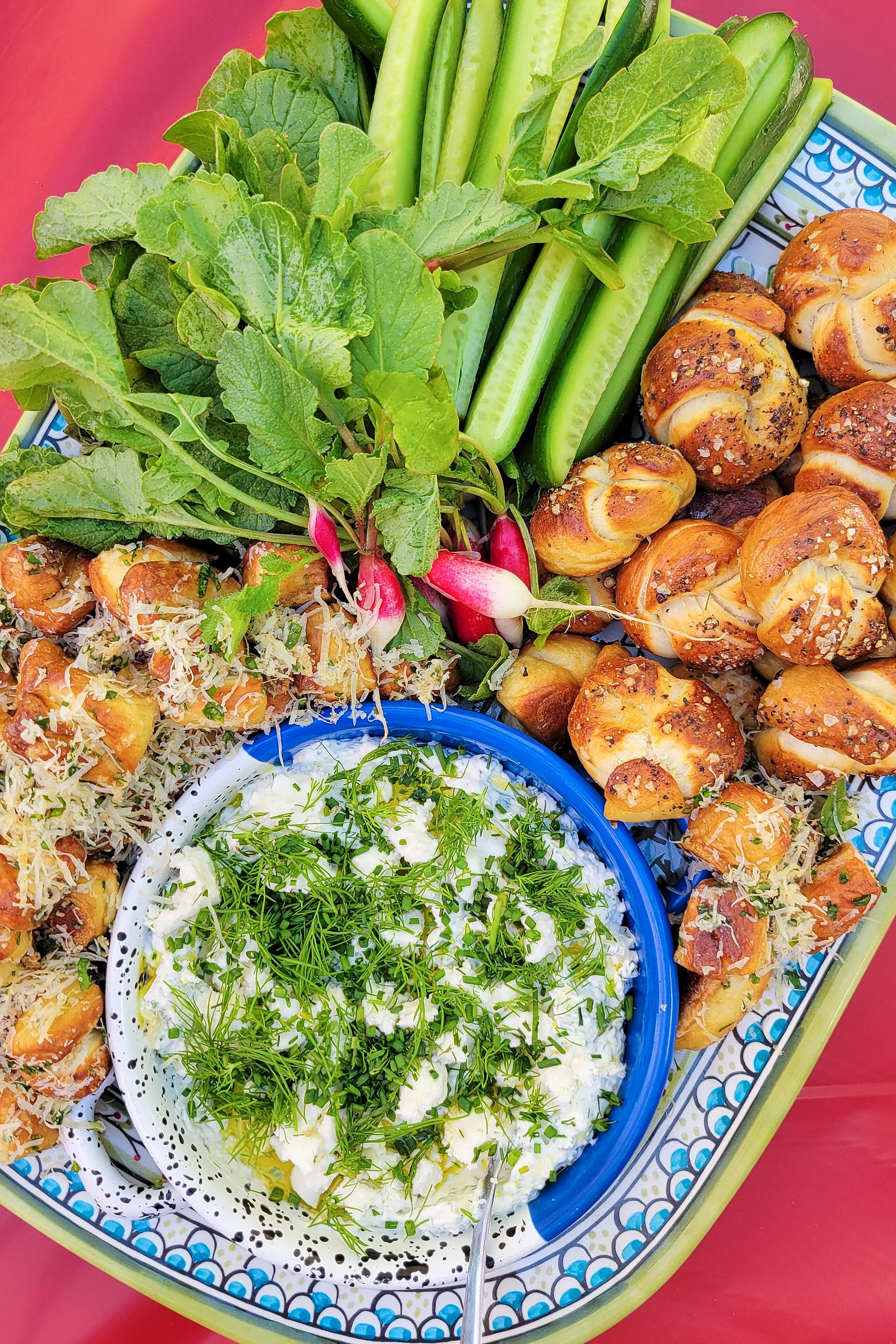Carrot-Habanero Hummus + 2 More Easy Dips
Bring big, bold, punchy flavor to your backyard BBQs, picnics, and summer eating!
Come July, summer barbecue and picnic season is in full motion! When it comes to sunshine-y feasting, grilling gets all the glory, but I’m here to advocate for the snacks, particularly dips, dips, and more dips. In fact, every Fourth of July, it’s mandatory that I bring my feta-labneh dip, soft pretzels, and crisp veg-dippers. But, why stop at one dip? Here are the three that have been heavy on my rotation this summer.
First up: Carrot-habanero hummus. Born out of a clean-out-the-fridge moment, it combines steamed carrots, habanero, and lime with the usual hummus suspects—chickpeas, tahini, and garlic—to create the creamiest, dreamiest dip with a rooty sweetness and bright, fruity heat. Some people will say to peel the chickpeas, but I’ve never been patient enough for that. My trick is blending the dip when the carrots are still warm and adding some of the liquid from the can of chickpeas—it results in ultra silkiness every single time.
Up next, my “famous” feta-labneh dip, which is truly one of the simplest dips you can make. Mash labneh and feta together, fold in lots of tender green herbs, lemon zest, and some dehydrated onion flakes, and you’re done! And, lastly, good ol’ olive tapenade. My version of this French fave amps up the herbs with parsley and basil, plus green and kalamata olives, capers, lemon zest, garlic, and the optional anchovy fillet or two.
This trifecta of dips are perfect party mates. You’ve got something spicy, sweet, and plant-based, something creamy and bright with citrus zest ‘n’ zip, and lastly, something bold and briny. That being said, any of these dips shine on their own, too. And, if you have any leftovers, each one of these can be repurposed into bigger meals, like as a base for grilled shrimp, a spread for sandwiches, or even magicked into a dressing for potato salad or grilled veggies. Keep reading for the recipes, plus ways to use leftover dip in every headnote.
Carrot-Habanero Hummus with Spiced Chickpeas
This dip is highly snackable scooped up with warm pita, but it’s also a prime candidate for extending into a heftier meal. The first time I made it, I used it as a base for grilled shrimp, simply seasoned with smoked paprika and salt, and romanesco (pictured below), and then I just spooned the herby, spiced chickpeas over everything as a garnish. But, this would be an equally tasty base for grilled chicken, lamb, or a combo summer squash and halloumi.
Makes 1½ cups (Serves 4 to 6)
INGREDIENTS
2 medium carrots
One 15-ounce can chickpeas
4 tablespoons extra virgin olive oil
2 tablespoons tahini paste
1 teaspoon maple syrup
½ to 1 habanero pepper, seeds and ribs removed and roughly chopped
3 garlic cloves, finely chopped
1 lime
1½ teaspoons Diamond Crystal or ¾ teaspoon Morton’s kosher salt
1 teaspoon coriander seeds, lightly crushed
½ teaspoon cumin seeds
⅓ cup roughly chopped cilantro
Flaky sea salt, for finishing
Pinch of Piment d’Espelette, Urfa Pepper, or Guntur Sannam chili powder, for finishing, optional
METHOD
Place a steamer basket in a medium saucepan or pot with 1½” of water, cover, and bring to boil over medium-high heat. Meanwhile, peel 2 medium carrots and cut into 1½” pieces. When the water is boiling, place the peel, cut carrots into the steam, cover, reduce the heat to medium-low, and steam until fully cooked through and easily pierced with a paring knife, 12 to 18 minutes.
While the carrots are steaming, drain one 15-ounce can chickpeas over a bowl to catch the liquid from the can. Transfer 1 cup of the drained chickpeas, reserving the rest for later use and ⅓ cup of the chickpea liquid to a blender (keep the leftover chickpea liquid just in case the dip needs to be thinned). Add 2 tablespoons extra virgin olive oil, 2 tablespoon tahini paste, 1 teaspoon maple syrup, ½ to 1 seeded, roughly chopped habanero pepper, half of the finely chopped garlic (1½ cloves), the zest of 1 lime, the juice of ½ lime (about 1 tablespoon), and 1 teaspoon Diamond Crystal or ½ teaspoon Morton’s kosher salt.
Add the steamed carrots to the blender when they are still hot (the residual heat will aid in a smooth, creamy texture). Start blending on low, increasing the speed to high, and blend until smooth, thick, and creamy. If the mixture is a little too thick, you can add 1 tablespoon of the leftover chickpea liquid at a time until you reach the desired consistency. Taste and season with salt, if necessary, blending to combine.
To make the topping, place the remaining 2 tablespoons extra virgin olive oil over medium heat. When shimmering, add 1 teaspoon lightly crushed coriander seeds and ½ teaspoon cumin seeds, and cook, stirring occasionally, until they turn a shade darker, 30 seconds to 1 minute. Add the remaining half of the finely chopped garlic (1½ cloves), and cook, stirring frequently, until the garlic starts to turn light golden around the edges, 30 seconds to 1 minute. Stir in the remaining drained chickpeas and ½ teaspoon Diamond Crystal or ¼ teaspoon Morton’s sea salt, and cook until heated through, 2 to 4 minutes. Turn off the heat, add ⅓ cup roughly chopped and the juice of the remaining ½ lime (about 1 tablespoon), and stir to combine. Taste and season with more salt, if necessary.
To serve, transfer the carrot hummus to a shallow serving bowl, spooning it into a mound in the center of the bowl. Place the back of a spoon on top of the hummus, apply gentle pressure, start to move the spoon in a circle, and rotate the bowl in the opposite direction—this will create an artful swoosh! Spoon the spiced chickpeas over the hummus and finish with an extra drizzle of olive oil, sprinkle of flaky sea salt and a pinch of Piment d’Espelette, Urfa Pepper, or Guntur Sannam chili powder, if desired.
Make-ahead: The dip and spiced chickpeas—just skip adding the cilantro to the topping until ready to serve—can be made up to 1 day in advance, and stored separately in the refrigerator. Since the olive oil can congeal, let the chickpea topping come to room temperature for about 10 to 15 minutes before serving.
Herby Feta-Labneh Dip
This dip loves carbs and veggies in equal measure. Enjoy it with a variety of bready goodness—like pita, sliced baguette, focaccia, or even soft pretzels (see photo below)—and/or a variety of fresh, crunchy veg-dippers, like radishes, baby carrots, snap peas, and cucumbers. If you have any leftovers, here are three more ways to use this versatile dip:
Spread on toast and topped with sliced heirloom tomatoes, a drizzle of olive oil, flaky sea salt, and cracked black pepper. This is also a great vessel for thinly sliced cucumber or smoked salmon, too!
Served alongside chicken—roasted, grilled, whatever!—salmon, or grilled veggies.
Tossed with canned, drained chickpeas, thinly sliced or diced cucumber, halved cherry tomatoes, some minced serrano pepper, if you want to make it a little spicy, and an extra squeeze of lemon juice, then tucked into a warm pita.
A note about feta: Go for a softer feta for this dip, like French (Valbreso is a great brand that’s widely available), Bulgarian, or good-quality Greek. Skip American-made ones like Belfiore.
Makes 1½ cups (Serves 4 to 6)
INGREDIENTS
⅔ cup labneh
4 ounces feta (see headnote)
Zest of 1 lemon
1 tablespoon lemon juice
¼ cup roughly chopped dill, plus more for garnish
¼ cup minced chives, plus more for garnish
2 teaspoons dehydrated onion flakes
Kosher salt, to taste
Extra virgin olive oil, for finishing
METHOD
Combine ⅔ cup labneh, 3 ounces feta, the zest of 1 lemon, and 1 tablespoon lemon juice in a medium bowl. Using a fork, mash the feta into the labneh until incorporated (some small chunks are okay!). Add ¼ cup roughly chopped dill, ¼ cup minced chives, 2 teaspoon dehydrated onion flakes, and crumble in the remaining 1 ounce feta, and gently stir to combine. Taste and season with salt, if necessary. Cover and refrigerate for at least 30 minutes to let the dehydrated onion to rehydrate and the flavors to marry.
To serve, transfer the feta-labneh dip to a shallow serving bowl, artfully swoosh, drizzle with extra virgin olive oil, and garnish with a sprinkling of chopped dill and minced chives.
Make-ahead: This dip can be made up to 2 days in advance with the herbs, and then garnished right before serving. You can also make the base without the herbs up to 4 days in advance and then mix in the herbs and garnish the day of. Store leftovers in an airtight container in the refrigerator for up to 1 week, but the herbs might lose a little bit of their color.
Olive Tapenade
Serve with crusty bread, grilled focaccia, crostini, or rustic crackers like taralli or toketti (I love the Mitica Toketti, which you can find at Whole Foods and some specialty food stores). This also makes a wonderful spread in sandwiches—my favorite is focaccia or ciabatta with some of this tapenade, some leftover grilled vegetables (like peppers, eggplant, and zucchini), and fresh mozzarella, but it’s equally delicious with cold rotisserie chicken, thick slices of seasoned tomatoes, arugula, and a bit of mayo or with your go-to cold cuts.
If I’m left with a couple tablespoons of tapenade after a party, I’ll save it and whisk it with a little Dijon mustard, lemon juice, and more olive oil for an easy dressing for potatoes, green beans, tomatoes, or grilled zucchini.
Makes 1 cup (Serves 4 to 6)
INGREDIENTS
½ cup pitted mild green olives, like Nocellara del Belice (Castelvetrano), picholine, or gordal
½ cup pitted kalamata olives
½ cup flat-leaf parsley leaves, lightly packed
½ cup roughly chopped basil
2 to 3 tinned anchovy fillets, roughly chopped, optional
Zest of 1 lemon, optional
1½ tablespoons lemon juice
1 fat garlic clove or 2 small-to-medium ones, finely grated
1 tablespoon capers, drained (if salt-cured, rinsed well)
⅓ cup extra virgin olive oil
Kosher salt, to taste
METHOD
Place ½ cup pitted mild green olives, ½ cup pitted kalamata olives, ½ cup lightly packed flat-leaf parsley leaves, ½ cup roughly chopped basil, 2 to 3 roughly chopped anchovy fillets, if using, the zest of 1 lemon, if using, 1½ tablespoons lemon juice, 1 finely grated garlic clove, and 1 tablespoon drained capers, and pulse until just barely finely chopped, 10 to 20 pulses. Scrape down the sides, and then with the motor running, drizzle in ⅓ cup extra virgin olive oil in a steady stream and blend, stopping to scrape down the sides as necessary, until it comes together into a medium fine paste (you still want it to be quite rustic, yet spreadable texture), 15 to 45 seconds.
Transfer to a small bowl, taste, and season with salt, if necessary, and additional lemon juice, if desired. Let sit at room temperature for 15 minutes to let the flavors marry before serving, or cover and refrigerate until serving. If serving later, remove the tapenade from the refrigerator 10 to 15 minutes before to let the oil come back to room temperature.
Make-ahead: This dip is one that stays good in the fridge for a long time. You can make it up to 3 to 4 days in advance, and keep any leftovers in an airtight container in the refrigerator for up to 2 weeks.







